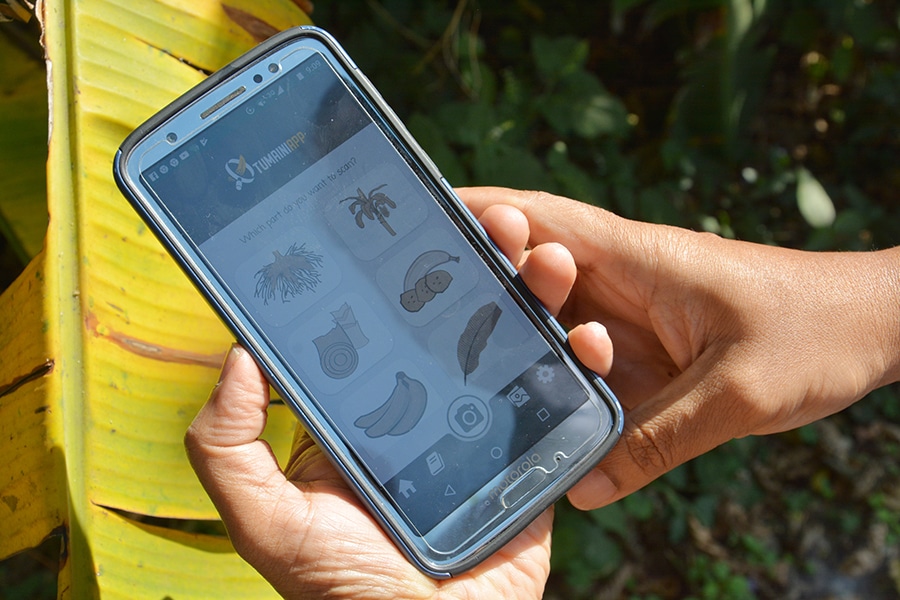Aug 13 2019
Artificial intelligence-powered tools are quickly becoming widely available, including for people in very remote corners of the world. This is encouraging for smallholder farmers, who can use handheld technologies to manage their farms more efficiently, connecting them to climate information, satellite images, extension workers, and markets. The technology is also becoming a first line of protection against crop diseases and pests that can possibly destroy their harvests.
 (Image credit: CIAT)
(Image credit: CIAT)
A new smartphone tool created for banana farmers scans plants for signs of five main diseases and one common pest. In testing in Colombia, China, India, Benin, the Democratic Republic of the Congo, and Uganda, the tool delivered a 90% successful detection rate. This work is a step towards creating a satellite-driven, internationally connected network to control disease and pest epidemics, say the scientists who created the technology.
The findings have been published recently in the journal Plant Methods.
“Farmers around the world struggle to defend their crops from pests and diseases,” said Michael Selvaraj, the lead author, who developed the tool with colleagues from Bioversity International in Africa. “There is very little data on banana pests and diseases for low-income countries, but an AI tool such as this one offers an opportunity to improve crop surveillance, fast-track control and mitigation efforts, and help farmers to prevent production losses.”
Co-authors included scientists from India’s Imayam Institute of Agriculture and Technology (IIAT), and Texas A&M University.
Bananas are the world’s most popular fruit and with the worldwide population estimated to hit 10 billion in 2050, pressure is growing to produce adequate food. Numerous countries will continue relying on international trade to guarantee their food security. It is estimated that by 2050 developing countries’ net imports of cereals will increase more than twofold from 135 million metric tons in 2008/09 to 300 million in 2050.
An important staple food for numerous families, bananas are a vital source of nutrition and income. However, pests and diseases, such as Xanthomanas wilt of banana, black leaf streak (or Black sigatoka), and Fusarium wilt threaten to harm the fruit. And when a disease epidemic hits, the effects to smallholder incomes can be detrimental.
In a few examples where losses to the Fusarium Tropical race 4 fungus have been estimated, they amounted to US$253.3 million in Taiwan, US$121 million in Indonesia, and US$14.1 million in Malaysia (Aquino, Bandoles and Lim, 2013). In Africa, where the fungus was first noticed in 2013 in a plantation in northern Mozambique, the number of symptomatic plants rose to over 570,000 in September 2015.
The tool is integrated into an app named “Tumaini”—which means “hope” in Swahili—and is intended to help smallholder banana growers swiftly detect a pest or disease and prevent a widespread outbreak from taking place. The app aims to connect them to extension workers to speedily curb the outbreak.
It can also upload data to a worldwide system for large-scale monitoring and control. The goal of the app is to allow a strong and straightforwardly deployable response to assist banana farmers in need of crop disease control.
The overall high accuracy rates obtained while testing the beta version of the app show that Tumaini has what it takes to become a very useful early disease and pest detection tool. It has great potential for eventual integration into a fully automated mobile app that integrates drone and satellite imagery to help millions of banana farmers in low-income countries have just-in-time access to information on crop diseases.
Guy Blomme, Bioversity International
Deep learning
Speedy optimizations in image-recognition technology made the Tumaini app achievable. To build it, scientists uploaded 20,000 images that showed different visible banana disease and pest symptoms. With this data, the app scans photos of portions of the fruit, bunch, or plant to establish the nature of the pest or disease. It then offers the steps needed to resolve the particular disease.
Furthermore, the app also records the data, such as geographic location, and feeds it into a bigger database.
Present-day crop disease detection models concentrate mainly on leaf symptoms and can only accurately work when pictures show detached leaves on a plain background. The innovation in this app is that it can detect signs on any part of the crop, and is programmed to be able to read images of lower quality, inclusive of background noise, like other leaves or plants, to increase accuracy.
This is not just an app. But a tool that contributes to an early warning system that supports farmers directly, enabling better crop protection and development and decision making to address food security.
Michael Selvaraj, Study Lead Author, CIAT
This study, executed by the Alliance between Bioversity International and the International Center for Tropical Agriculture (CIAT), has demonstrated the potential of innovative technologies such as robotics, AI, Internet of Things (IoT), cloud computing, satellites, and machine learning for the revolution of agriculture and for aiding farmers.
Tumaini Mobile App
(Video credit: CIAT)